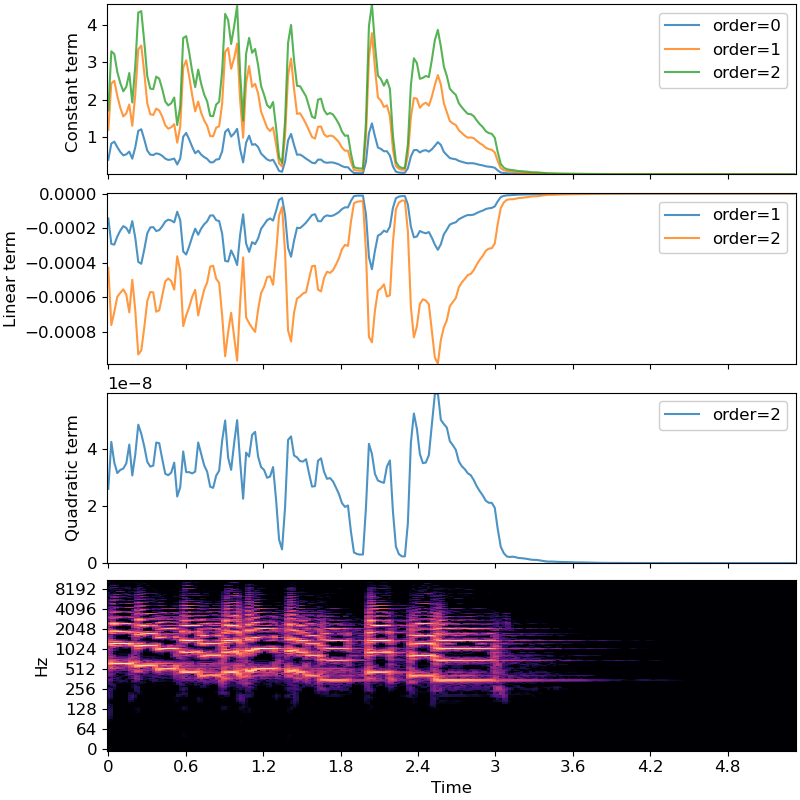Caution
You're reading the documentation for a development version. For the latest released version, please have a look at 0.9.1.
librosa.feature.poly_features¶
- librosa.feature.poly_features(*, y=None, sr=22050, S=None, n_fft=2048, hop_length=512, win_length=None, window='hann', center=True, pad_mode='constant', order=1, freq=None)[source]¶
Get coefficients of fitting an nth-order polynomial to the columns of a spectrogram.
- Parameters
- ynp.ndarray [shape=(…, n)] or None
audio time series. Multi-channel is supported.
- srnumber > 0 [scalar]
audio sampling rate of
y- Snp.ndarray [shape=(…, d, t)] or None
(optional) spectrogram magnitude
- n_fftint > 0 [scalar]
FFT window size
- hop_lengthint > 0 [scalar]
hop length for STFT. See
librosa.stftfor details.- win_lengthint <= n_fft [scalar]
Each frame of audio is windowed by window(). The window will be of length win_length and then padded with zeros to match
n_fft.If unspecified, defaults to
win_length = n_fft.- windowstring, tuple, number, function, or np.ndarray [shape=(n_fft,)]
a window specification (string, tuple, or number); see
scipy.signal.get_windowa window function, such as
scipy.signal.windows.hanna vector or array of length
n_fft
- centerboolean
If True, the signal
yis padded so that frame t is centered aty[t * hop_length].If False, then frame
tbegins aty[t * hop_length]
- pad_modestring
If
center=True, the padding mode to use at the edges of the signal. By default, STFT uses zero padding.- orderint > 0
order of the polynomial to fit
- freqNone or np.ndarray [shape=(d,) or shape=(…, d, t)]
Center frequencies for spectrogram bins. If None, then FFT bin center frequencies are used. Otherwise, it can be a single array of
dcenter frequencies, or a matrix of center frequencies as constructed bylibrosa.reassigned_spectrogram
- Returns
- coefficientsnp.ndarray [shape=(…, order+1, t)]
polynomial coefficients for each frame.
coeffecients[..., 0, :]corresponds to the highest degree (order),coefficients[..., 1, :]corresponds to the next highest degree (order-1),down to the constant term
coefficients[..., order, :].
Examples
>>> y, sr = librosa.load(librosa.ex('trumpet')) >>> S = np.abs(librosa.stft(y))
Fit a degree-0 polynomial (constant) to each frame
>>> p0 = librosa.feature.poly_features(S=S, order=0)
Fit a linear polynomial to each frame
>>> p1 = librosa.feature.poly_features(S=S, order=1)
Fit a quadratic to each frame
>>> p2 = librosa.feature.poly_features(S=S, order=2)
Plot the results for comparison
>>> import matplotlib.pyplot as plt >>> fig, ax = plt.subplots(nrows=4, sharex=True, figsize=(8, 8)) >>> times = librosa.times_like(p0) >>> ax[0].plot(times, p0[0], label='order=0', alpha=0.8) >>> ax[0].plot(times, p1[1], label='order=1', alpha=0.8) >>> ax[0].plot(times, p2[2], label='order=2', alpha=0.8) >>> ax[0].legend() >>> ax[0].label_outer() >>> ax[0].set(ylabel='Constant term ') >>> ax[1].plot(times, p1[0], label='order=1', alpha=0.8) >>> ax[1].plot(times, p2[1], label='order=2', alpha=0.8) >>> ax[1].set(ylabel='Linear term') >>> ax[1].label_outer() >>> ax[1].legend() >>> ax[2].plot(times, p2[0], label='order=2', alpha=0.8) >>> ax[2].set(ylabel='Quadratic term') >>> ax[2].legend() >>> librosa.display.specshow(librosa.amplitude_to_db(S, ref=np.max), ... y_axis='log', x_axis='time', ax=ax[3])
